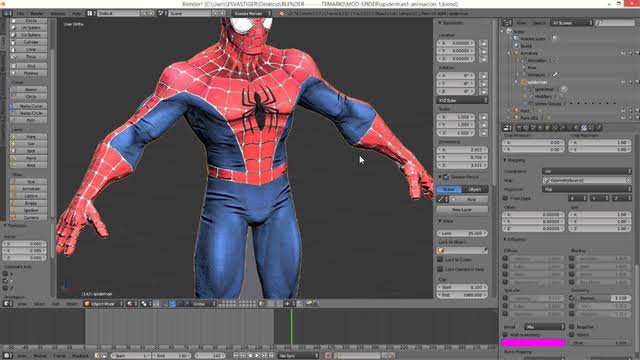
Are you considering a career as a junior 3D animator? Whether you’re a recent graduate or looking to transition into the field, understanding the role, the industry, and what it takes to succeed is crucial. In this blog post, we’ll explore the ins and outs of being a junior 3D animator, including the key skills required, the impact of experience on salary, and the importance of building a strong presence on LinkedIn. We’ll also delve into career growth opportunities, negotiating salary, and the benefits and perks commonly offered in the industry. Whether you’re just starting out or looking to advance your career, this post has got you covered.
Contents
- 1 What Is A Junior 3D Animator?
- 2 Importance Of Linkedin For 3D Animators
- 3 Key Skills Required For A Junior 3D Animator
- 4 How Does Experience Affect Salary?
- 5 Average Salary Range For Junior 3D Animators On Linkedin
- 6 Factors That Influence Salary In The Field
- 7 How Location Impacts Junior 3D Animator Salaries
- 8 Additional Certifications And Their Impact On Salary
- 9 Career Growth Opportunities For Junior 3D Animators
- 10 Negotiating Salary As A Junior 3D Animator
- 11 Benefits And Perks Commonly Offered In The Industry
- 12 Tips For Building A Strong Linkedin Profile As A Junior 3D Animator
- 13 Frequently Asked Questions
What Is A Junior 3D Animator?
A Junior 3D Animator is a professional who specializes in creating and manipulating visual effects for various forms of media, such as films, television shows, video games, and advertisements. They use computer software to design and animate characters, objects, and backgrounds, bringing them to life through movement and visual effects. Junior 3D Animators work under the guidance of experienced animators and are responsible for assisting in the creation of high-quality animations. They typically work in animation studios, game development companies, advertising agencies, and film production houses.
One of the essential tools for a Junior 3D Animator is a strong presence on LinkedIn. LinkedIn is a professional networking platform that allows individuals to showcase their skills, experience, and accomplishments to potential employers and connections in the industry. For 3D Animators, LinkedIn provides a platform to display their portfolio, share their work, and connect with other professionals in the field. It is a valuable resource for finding job opportunities, collaborating on projects, and staying up-to-date with the latest industry trends and advancements.
As a Junior 3D Animator, there are several key skills that are crucial for success in the field. Strong artistic and creative abilities are essential, as animators are responsible for bringing characters and objects to life through movement and expression. Proficiency in various animation software such as Autodesk Maya, Adobe After Effects, and Cinema 4D is also important. Additionally, attention to detail, teamwork, problem-solving skills, and the ability to meet deadlines are highly valued in the industry.
Importance Of Linkedin For 3D Animators
LinkedIn has become an integral platform for professionals in various industries, including 3D animation. It has transformed the way individuals connect, network, and find job opportunities. For junior 3D animators, having a strong presence on LinkedIn is of utmost importance for several reasons.
Firstly, LinkedIn allows 3D animators to showcase their skills, experience, and portfolio to a global audience. By creating a well-structured and visually appealing profile, junior animators can attract the attention of potential employers, clients, and collaborators. They can highlight their proficiency in software tools such as Autodesk Maya or Adobe After Effects, which are essential for working in the field.
Secondly, LinkedIn provides a platform for networking and building professional relationships within the animation industry. Junior animators can connect with established professionals, join relevant groups, and participate in discussions to expand their knowledge and industry connections. These interactions can lead to mentorship opportunities, internships, and even job offers.
- LinkedIn also offers various features to help 3D animators stay up to date with industry trends and job openings. By following relevant companies and industry influencers, junior animators can access valuable insights and updates about the latest techniques, software advancements, and project announcements.
Moreover, LinkedIn acts as a powerful job search tool for 3D animators. Many companies and recruiting agencies rely on LinkedIn to find potential candidates for their animation projects. By regularly updating their profiles and indicating their availability, junior animators can increase their chances of being noticed by recruiters and securing job opportunities. Additionally, LinkedIn’s job search feature allows animators to filter through relevant positions based on location, experience level, and other criteria.
In terms of salary, LinkedIn can play a significant role in helping junior 3D animators negotiate better compensation packages. By conducting research and connecting with peers in the industry, animators can gain insights into industry standards for salary and benefits. They can also use LinkedIn’s salary insights tool to compare their compensation with others in similar roles.
In conclusion, having a strong presence on LinkedIn is crucial for junior 3D animators. It offers a platform to showcase their skills, network with professionals, stay updated with industry trends, find job opportunities, and negotiate better salaries. By utilizing LinkedIn effectively, 3D animators can enhance their career prospects and open doors to new opportunities in the exciting field of animation.
| Junior 3D Animator | Salary | |
|---|---|---|
| Platform | Skills | Professional relationships |
| Job search | Compensation packages | Networking |
Key Skills Required For A Junior 3D Animator
As a junior 3D animator, possessing certain key skills is essential for success in the field. These skills not only differentiate you from other candidates but also play a crucial role in your professional growth. Let’s explore some of the key skills required for a junior 3D animator:
1. Technical Proficiency: A strong foundation in technical skills is a must for every junior 3D animator. This includes proficiency in software such as Autodesk Maya, Cinema 4D, or Blender. Familiarity with different animation techniques, rigging, texturing, and lighting is also necessary.
2. Creativity and Imagination: A junior 3D animator needs to have a creative and imaginative mind to bring characters, objects, and scenes to life. They must be able to conceptualize ideas and translate them into visually appealing animations.
3. Attention to Detail: An eye for detail is crucial in the field of 3D animation. Junior animators must pay close attention to the minute nuances of movements, lighting, and textures to create realistic and visually appealing animations.
4. Strong Communication Skills: Effective communication is vital for collaborating with team members, understanding project requirements, and receiving feedback. Junior animators should be able to articulate their ideas clearly and work well within a team environment.
5. Problem-Solving Abilities: Animation projects often come with technical challenges and constraints. Junior animators should possess problem-solving skills to overcome hurdles and find innovative solutions to ensure project completion within deadlines.
6. Time Management: Meeting deadlines is of utmost importance in the animation industry. Junior animators need to efficiently manage their time, prioritize tasks, and work under pressure to meet project timelines.
These key skills are highly valued in the industry and play a significant role in the career growth of junior 3D animators. Developing and honing these skills can open doors to exciting opportunities in the field of animation.
How Does Experience Affect Salary?
Experience plays a significant role in determining the salary of a junior 3D animator. As with any profession, the more experience one gains, the higher the salary they can command.
In the field of 3D animation, experience not only reflects the number of years an animator has worked but also the quality and complexity of the projects they have undertaken.
The LinkedIn Junior 3D Animator Salary data indicates that entry-level animators with less than two years of experience earn an average annual salary of $40,000 to $50,000. However, as animators progress in their careers and accumulate more experience, their earning potential increases significantly.
For instance, 3D animators with five to nine years of experience can earn an average salary of $60,000 to $80,000 per year, while those with ten or more years of experience can command an impressive annual salary of $80,000 or more.
- Experience not only affects the salary directly but also indirectly influences career growth opportunities.
- Employers often prioritize candidates with a higher level of experience, leading to an increased likelihood of promotions or access to more challenging and better-paying projects.
In summary, experience is a crucial factor that directly influences salary for junior 3D animators. The more experience an animator possesses, the higher their earning potential becomes. As animators accumulate years of experience and tackle more complex projects, they can expect steady salary growth and increased career opportunities in the field.
Average Salary Range For Junior 3D Animators On Linkedin
When considering a career in animation, it is important to understand the salary range for junior 3D animators. An animator’s salary can vary depending on a variety of factors such as experience, skills, location, and additional certifications. LinkedIn, the professional networking platform, can be a valuable resource for researching salary information and connecting with industry professionals.
One of the key factors that can impact a junior 3D animator’s salary is their level of experience. As with many professions, the more experience an animator has, the higher their earning potential. Entry-level junior animators may start at a lower salary, while those with several years of experience and a strong portfolio can command higher rates.
According to data from LinkedIn, the average salary range for junior 3D animators falls between $40,000 and $70,000 per year. However, it is important to note that this range can vary based on factors such as location and industry demand. Animators working in major animation studios or locations with a high cost of living may earn salaries at the upper end of the range.
Factors That Influence Salary In The Field
In the field of 3D animation, the salary of a junior animator can vary depending on a variety of factors. These factors can significantly influence the earning potential of an individual and determine the financial growth in their careers. It is important to understand these factors to make informed decisions and negotiate a fair salary package. Let’s explore some of the key factors that play a role in determining the salary of a junior 3D animator.
1. Experience: Experience is a crucial factor when it comes to determining the salary of a junior 3D animator. As with any profession, the more experience an individual has, the higher their earning potential. An animator with several years of experience will generally earn a higher salary compared to someone who has just entered the field. This is because experienced animators have developed a strong skill set and are likely to have worked on a range of projects, showcasing their expertise.
2. Specialization: Another influencing factor is the specialization of the junior 3D animator. There are various areas within 3D animation, such as character animation, visual effects, motion graphics, and architectural visualization. Animators who specialize in high-demand areas or possess unique skills tend to command higher salaries. Employers value specialists who can bring a specific expertise and contribute to the success of a project.
3. Location: The location of the job also plays a significant role in determining the salary of a junior 3D animator. Salaries can vary greatly depending on the cost of living in a particular area. For example, animators working in major cities or animation hubs may receive higher salaries compared to those working in smaller towns or remote areas. It is important to consider the cost of living when assessing job opportunities and salary expectations.
| Factors That Influence Salary |
|---|
| Experience |
| Specialization |
| Location |
These factors, along with others such as the company size, industry demand, and the individual’s portfolio, can all contribute to the salary range of a junior 3D animator. It is essential for aspiring animators to research and understand the industry standards, market trends, and demand for specific skills before starting their careers. Additionally, building a strong network on professional platforms like LinkedIn can provide valuable insights into salary expectations and career growth opportunities. By considering these factors and staying updated with industry trends, junior 3D animators can make informed decisions and strive for a rewarding and financially satisfying career.
How Location Impacts Junior 3D Animator Salaries
Location plays a significant role in determining the salary of a junior 3D animator. The cost of living, demand for the skillset, and industry presence all contribute to the variation in salaries across different locations. In this blog post, we will explore how location impacts the salaries of junior 3D animators.
Firstly, it is important to note that major cities with a strong entertainment industry tend to offer higher salaries for junior 3D animators. These cities, such as Los Angeles, Vancouver, and London, have a high demand for animation talent and therefore provide more opportunities for junior animators. The competition for skilled animators drives up the salaries in these locations as companies strive to attract and retain top talent.
Secondly, the cost of living in a particular area can also influence the salary for a junior 3D animator. For example, cities with a higher cost of living like San Francisco or New York City often offer higher salaries to compensate for the increased expenses employees may face. A higher salary is necessary to maintain a decent standard of living and cover housing, transportation, and other essential costs.
- Keywords used: LinkedIn Junior 3D Animator Salary
- Keywords used: salary range, junior 3D animators, LinkedIn
| City | Average Salary Range (per year) |
|---|---|
| Los Angeles | $50,000 – $80,000 |
| Vancouver | $45,000 – $70,000 |
| London | £30,000 – £50,000 |
Lastly, it’s important to consider the presence of animation studios and companies in a particular location. Areas with a high concentration of animation studios, such as Hollywood in Los Angeles or the 3D animation hub in Vancouver, tend to have higher salaries due to the demand and competition for talent. These locations offer more career growth opportunities and potentially better perks and benefits, which can further enhance the overall compensation package for junior 3D animators.
In conclusion, location significantly impacts the salaries of junior 3D animators. Living in a city with a strong animation industry presence, high demand for skilled animators, and a higher cost of living can lead to higher salaries. It is crucial for aspiring animators to research and consider these factors when deciding on their career path and negotiating their salary.
Additional Certifications And Their Impact On Salary
As a junior 3D animator, having additional certifications can significantly impact your salary potential. These certifications not only allow you to enhance your skills and knowledge in specific areas of 3D animation but also make you stand out in a competitive job market. In this blog post, we will discuss the importance of additional certifications and how they can positively affect your salary as a junior 3D animator.
One of the key benefits of earning additional certifications as a junior 3D animator is the opportunity to specialize in a specific niche within the field. Whether it’s character animation, visual effects, or motion graphics, pursuing certifications in these areas demonstrates your dedication and expertise in a particular skill set. Employers value specialization, and having certifications in specific areas can make you a more attractive candidate, ultimately leading to higher salary offers.
Moreover, additional certifications showcase your commitment to professional development and staying updated with the latest industry trends and technologies. As the field of 3D animation continues to evolve rapidly, employers seek candidates who are adaptable and have a willingness to learn. By obtaining certifications, you demonstrate your ability to continuously enhance your skills and keep up with industry advancements, which can certainly impact your salary potential.
| Certification | Impact on Salary |
|---|---|
| Autodesk Maya Certified Professional | Higher salary offers due to expertise in industry-standard software |
| Adobe After Effects Certified Expert | Increased demand and higher salary potential for compositing and motion graphics roles |
| Unity Certified 3D Artist | Higher salary offers for positions requiring real-time 3D animation and game development skills |
| Certified Blender Artist | Enhanced salary potential for open-source 3D animation projects and freelance opportunities |
By listing these certifications on your LinkedIn profile, you can attract the attention of potential employers and showcase your expertise in specific areas of 3D animation. LinkedIn serves as an invaluable platform for networking and job searching within the industry. Recruiters often use LinkedIn to find candidates with the desired skills and qualifications for their job openings. Therefore, having a strong LinkedIn presence can significantly increase your chances of landing high-paying job opportunities.
In conclusion, additional certifications play a crucial role in shaping the salary potential of junior 3D animators. These certifications not only allow for specialization and increased expertise but also demonstrate a commitment to professional growth and development. By acquiring relevant certifications and effectively promoting them on platforms like LinkedIn, you can significantly impact your salary as a junior 3D animator and open doors to exciting career opportunities in the field.
Career Growth Opportunities For Junior 3D Animators
As a Junior 3D Animator, there are various career growth opportunities that you can explore in the field. Whether you are just starting out or have a few years of experience under your belt, it is important to be aware of the potential paths you can take to advance your career and enhance your skills.
One of the first career growth opportunities for Junior 3D Animators is the chance to specialize in a specific area of animation. This could be character animation, visual effects, motion graphics, or even game animation. By focusing on a particular area, you can become an expert in that field and increase your chances of landing more specialized and higher-paying jobs.
Another career growth opportunity for Junior 3D Animators is the chance to move up into a senior or lead animator role. This typically requires gaining more experience and showcasing your skills and leadership abilities. By taking on more responsibilities and leading a team of animators, you can not only increase your salary but also gain valuable experience in managing projects and mentoring other junior animators.
- LinkedIn: Utilizing LinkedIn is crucial for Junior 3D Animators to network and discover new career opportunities. By creating a strong LinkedIn profile, you can showcase your skills, connect with professionals in the industry, and stay up to date on job openings and industry trends.
- Junior 3D Animator: By continuously improving your skills and staying updated with the latest software and techniques, you can become a sought-after Junior 3D Animator and have more career growth opportunities. Consider attending workshops, taking online courses, or joining professional organizations to enhance your skills and knowledge in the field.
- Salary: As you progress in your career as a Junior 3D Animator, it is natural to expect an increase in salary. However, factors such as experience, location, and additional certifications can influence the salary range. Utilize salary research tools on LinkedIn to gain insights into the average salary range for Junior 3D Animators and negotiate your salary effectively.
| Factors Influencing Career Growth Opportunities |
|---|
| 1. Experience |
| 2. Skills and specialization |
| 3. Leadership abilities |
| 4. Networking and industry connections |
| 5. Continuous learning and professional development |
In conclusion, there are ample career growth opportunities for Junior 3D Animators in the industry. By specializing in a specific area, aiming for senior roles, utilizing LinkedIn for networking and job openings, continuously improving skills, and understanding the factors influencing salary, you can pave the way for a successful and rewarding career in 3D animation.
Negotiating Salary As A Junior 3D Animator
As a Junior 3D Animator, negotiating your salary is an important step in building your career. While it can be intimidating, it is crucial to ensure that you are being fairly compensated for your skills and contributions. In this blog post, we will discuss some tips and strategies for negotiating salary as a Junior 3D Animator.
1. Research the market: Before entering any salary negotiation, it is essential to have a clear understanding of the average salary range for Junior 3D Animators on LinkedIn or other industry-specific platforms. This will provide you with a benchmark to assess the value of your skills and experience in the current job market.
2. Highlight your skills and achievements: During salary negotiations, be sure to emphasize your unique skill set and accomplishments as a Junior 3D Animator. Whether it’s a particular software expertise or successful animation projects, showcasing your abilities can help justify a higher salary.
3. Consider additional certifications: Gaining additional certifications in 3D animation or related fields can significantly impact your salary negotiation. These certifications demonstrate your commitment to professional development and can make you more competitive in the job market.
4. Be confident but realistic: While it is important to negotiate for a fair salary, it is equally essential to be realistic about your experience level and market value. Overpricing yourself may result in missed opportunities, while underpricing yourself can lead to dissatisfaction in the long run.
| Factors that Influence Salary | Impact |
|---|---|
| Experience | Experienced animators generally command higher salaries. |
| Location | Salaries can vary based on the cost of living and demand for animators in different regions. |
| Additional Certifications | Having specialized certifications can lead to higher-paying opportunities. |
- 5. Be prepared to negotiate: Negotiating salary is a give-and-take process. Be prepared to make counteroffers and consider other factors such as benefits, perks, and career growth opportunities when discussing compensation.
- 6. Network and seek advice: Connect with other professionals in the industry, attend industry events, and seek advice from mentors or career coaches. Networking can provide valuable insights into salary expectations and negotiation strategies.
- 7. Stay up-to-date with industry trends: Keep yourself informed about the latest developments in the 3D animation industry. This knowledge can help you stay ahead of the curve and negotiate for competitive salaries based on current industry standards.
In conclusion, negotiating salary as a Junior 3D Animator requires thorough research, confidence, and understanding of your market value. By highlighting your skills, considering additional certifications, and being realistic in your expectations, you can successfully navigate salary negotiations and secure a package that reflects your worth in the animation industry.
Benefits And Perks Commonly Offered In The Industry
In the field of 3D animation, there are various benefits and perks commonly offered to junior animators. These additional incentives aim to attract and retain talented individuals in a highly competitive industry. While salary is an important factor, these benefits can greatly contribute to an animator’s overall job satisfaction and well-being.
One of the most common benefits offered in the industry is health insurance. Many companies provide comprehensive medical, dental, and vision coverage to their employees. This ensures that animators have access to quality healthcare and can take care of their well-being.
In addition to health insurance, many companies also offer retirement plans such as 401(k) options. This allows junior animators to save for their future and have a secure financial outlook. Employers often provide matching contributions to encourage employees to participate in these plans.
- Some companies provide flexible work schedules or remote work opportunities. This allows junior animators to have a better work-life balance and cater to their personal needs. It also provides the flexibility to work from anywhere, which can be highly desirable for individuals who prefer a nomadic lifestyle.
- Professional development and training opportunities are also commonly offered in the industry. Companies may sponsor workshops, conferences, or online courses to help junior animators enhance their skills and stay updated with the latest trends in animation technology. This not only benefits the employee but also the employer as they can leverage the increased expertise of their staff.
- Many companies also focus on creating a positive work environment by offering various perks. These can include free snacks and beverages, recreational facilities, or even company-sponsored team-building activities. These perks promote camaraderie among team members and contribute to a more enjoyable work atmosphere.
- In some cases, companies offer stock options or profit-sharing programs to their employees. This allows junior animators to have a share in the company’s success and reap financial benefits when the company performs well. It also motivates employees to work harder and contribute to the overall growth of the organization.
- Lastly, some companies provide employee discounts or exclusive deals with partner companies. These can range from discounted movie tickets to reduced prices on software or hardware relevant to the animation industry. Such discounts can help junior animators save money and make their overall compensation package more appealing.
In conclusion, the benefits and perks commonly offered in the animation industry go beyond just salary. From comprehensive health insurance to flexible work arrangements and professional development opportunities, these additional incentives play a vital role in attracting and retaining junior animators. They not only contribute to job satisfaction but also promote overall well-being and personal growth. It’s important for aspiring animators to consider these factors when evaluating potential job opportunities.
Tips For Building A Strong Linkedin Profile As A Junior 3D Animator
Building a strong LinkedIn profile is essential for any professional looking to make their mark in the industry. This holds true for junior 3D animators as well. LinkedIn serves as an online platform for connecting with industry peers, showcasing your skills and experience, and even finding job opportunities. In this blog post, we will discuss some valuable tips that can help junior 3D animators create a powerful LinkedIn profile that stands out from the crowd.
1. Create a Compelling Headline: Your headline is the first thing that people see when they visit your profile. It should be concise, yet descriptive enough to give viewers an idea of your professional identity. For instance, you can use a headline like “Creative and Dedicated Junior 3D Animator passionate about bringing imagination to life.”
2. Showcase Your Skills and Projects: To make your LinkedIn profile shine, highlight your key skills and projects. Utilize the “Featured” section to display your best work, such as animations, character designs, or any other relevant projects. This visual showcase can capture the attention of potential employers or clients and demonstrate your abilities as an animator.
3. Request Endorsements and Recommendations: Endorsements and recommendations from colleagues, mentors, or clients add credibility to your profile. Reach out to people who can vouch for your skills and request them to endorse your skills or write a recommendation. This will not only enhance your profile but also strengthen your professional reputation in the industry.
Frequently Asked Questions
What is a Junior 3D Animator?
A Junior 3D Animator is an entry-level position in the field of animation, specifically focused on creating three-dimensional animated visuals and effects.
Why is LinkedIn important for 3D Animators?
LinkedIn is important for 3D Animators as it provides a professional platform to showcase their skills, connect with industry professionals, and explore job opportunities in the field.
What are the key skills required for a Junior 3D Animator?
Key skills required for a Junior 3D Animator include proficiency in animation software, understanding of design principles, creativity, attention to detail, and strong communication abilities.
How does experience affect salary for 3D Animators?
Experience plays a significant role in determining the salary of 3D Animators. As experience increases, so does the level of expertise and the potential to take on more complex projects, leading to higher salaries.
What is the average salary range for Junior 3D Animators on LinkedIn?
The average salary range for Junior 3D Animators on LinkedIn varies depending on factors such as location, experience, skills, and industry demand. However, it typically falls between $40,000 and $60,000 per year.
What factors influence salary in the field of 3D animation?
Several factors influence salary in the field of 3D animation, including experience, skills, specialization, industry demand, geographical location, and the size and reputation of the employing company.
How does location impact Junior 3D Animator salaries?
Location can have a significant impact on Junior 3D Animator salaries. Major animation hubs or cities with a high cost of living often offer higher salaries compared to smaller towns or regions with a lower demand for animators.




